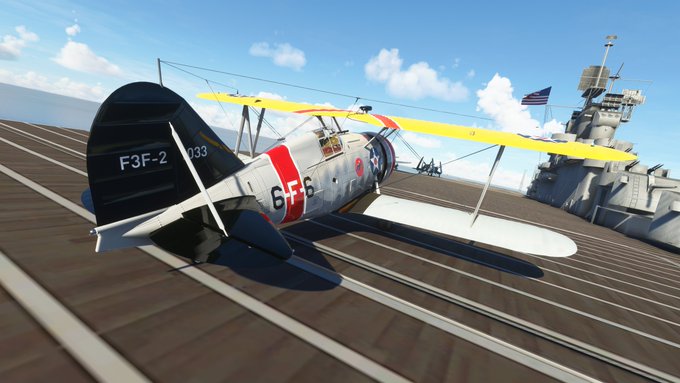December 13, 2022
Welcome back to Microsoft Flight Simulator for a ride in the US Navy’s main carrier fighter plane in the years just before World War II, the Grumman F3F-2.

To set the scene, I’m onboard the USS Essex (CV-9), off the east coast of Oahu.

It’s not a perfect match, but the Essex is a pretty close facsimile to the USS Wasp (CV-7), which this aircraft belongs to.

The F3F entered service in 1936 and was the last US biplane assigned to front-line combat units. Its nickname, because of its round stubby shape, was The Flying Barrel or the Beer Barrel.

The bulky fuselage was built to accommodate this: a 950 horsepower Pratt & Whitney Cyclone 9-cylinder radial engine, the same engine used on the B-17 bomber.

While the F3F may look like an older WWI-style biplane, it had many features that made it the direct predecessor of the monoplane US fighters of World War II, including a glass-enclosed cockpit.

Like most WWII fighter planes, the throttle, mixture control, and trim tabs are on the left.

The red handle on the right is a hand-crank for raising and lowering the retractable landing gear. This had to be done furiously by hand – 28 turns – no hydraulics or electronics involved.

To get the engine started, they inserted a charge like a shotgun shell, here in the left landing gear bay. Firing it produced enough pressure to turn the propeller and engage the magnetos. This may have been the origin of the term “gunning the engine”.

This device, protruding from the front windshield, is the telescopic sight for the guns. The F3F had two machine guns, a .30 cal and a .50 cal, in its nose, right above the engine.

A camera like this one could also be installed over the top wing to record hits in practice and combat, for later review.

The fuselage is metal and “monocoque”, which means the skin provides its own structural support. The wings, however, are fabric stretched over a frame and doped with paint.

All of the US carrier pilots in the fleet flew the F3F until the spring of 1941. Right up to the eve of the war, it was the main US Navy fighter.

These early carriers didn’t have catapults. You have to line up and just gather enough speed to stay airborne when the deck drops away. You also have to use the rudder to stay VERY STRAIGHT, which is hard due to the single-engine torque.

Nonetheless, I’m successfully off.

In the process of hand-cranking the wheels up. You can imagine how distracting this was just after takeoff.

That’s another carrier, the USS Enterprise (CV-6) below.

Climbing and turning back to the east, towards Oahu. Why a biplane, in 1936? The twin wings gave the F3F a lot of lift to get airborne fast off the carrier, and made it extremely maneuverable.

However, the twin wings also created a lot of drag. The F3F was fairly fast, with a max level speed of 250 knots or so, but it was noticeably slower than the Japanese Zero which could reach 288 knots.

Here I’m approaching Pearl Harbor at a cruising speed of 200 knots and an altitude of 2,000 feet.

Flying over Pearl Harbor in the Grumman F3F-2. The ships below are modern, but otherwise it could be 1940.

Now a little sightseeing over Honolulu.

The beach at Waikiki.

Diamondhead.

Making a turn back over the Diamondhead Crater.

Flying back west over Hickam Air Force Base. The shorter World War II runways have all been turned into taxiways and parking areas.

A good view of Pearl Harbor with Hickam Field to the right.

Now comes the trick – landing back on the aircraft carrier. I’ve slowed down to just over 100 knots and hand-cranked the landing gear down again.

Hope I hit those arrester cables. There are only three of them.

Back down on deck.

The year after the F3F was introduced, Grumman took the same basic design and reduced it to a single all-metal wing. This became the F4F Wildcat, which replaced the F3F starting in early 1941, just in time for the war.

As war approached, the F3F was relegated to training, but still played the much-needed role of training pilots to land on carrier decks.

Despite its outmoded appearance – and the fact that it never did fly in combat – the F3F Flying Barrel paved the way for more advanced carrier fighters, and served as a school for the US Navy pilots who later flew them.

[…] the time the U.S. Navy adopted the Grumman F3F (which I did a post on here) as it main carrier-based fighter, in the years immediate prior to World War II, Grumman was well […]